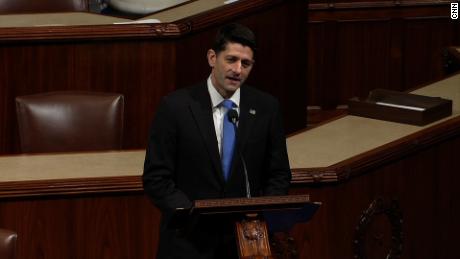Analyzing The GOP Tax Plan: The Reality Of Deficit Reduction

Table of Contents
Projected Revenue Impacts of the GOP Tax Plan
The GOP tax plan significantly altered the US tax code, resulting in substantial projected revenue changes. The centerpiece was a dramatic reduction in the corporate tax rate, from 35% to 21%. Simultaneously, individual income tax rates were also adjusted, with varying impacts across different income brackets. These changes had profound implications for government revenue.
-
Corporate Tax Rate Reductions: The reduction in the corporate tax rate was projected to decrease federal revenue significantly. While proponents argued this would stimulate investment and ultimately boost economic activity, leading to increased tax revenue in the long run, the initial impact was a substantial loss in government income. Analysis from the Congressional Budget Office (CBO) provides detailed projections on this revenue loss.
-
Individual Income Tax Changes: The individual income tax changes were more complex, affecting different income brackets differently. Some individuals experienced tax cuts, while others saw their tax burdens remain unchanged or even increase. The net effect on overall government revenue was a decrease, although the magnitude of the decrease was debated extensively. The CBO offered varied projections depending on economic assumptions.
-
Tax Breaks and Loopholes: The tax plan also included numerous tax breaks and loopholes, many of which further reduced government revenue. These provisions often benefited specific industries or groups, raising concerns about equity and exacerbating the overall revenue shortfall. Detailed analysis of these provisions can be found in various independent economic reports.
-
Data and Sources: Data supporting these claims can be found in reports from the Congressional Budget Office (CBO), the Joint Committee on Taxation (JCT), and independent economic analyses from organizations like the Tax Policy Center. These sources provide crucial context for understanding the revenue implications of the GOP tax plan.
Economic Growth Projections and the GOP Tax Plan
A central tenet of the GOP tax plan was the idea that significant tax cuts, particularly for corporations, would stimulate substantial economic growth. This was based on supply-side economics, which posits that lower taxes incentivize investment, job creation, and higher productivity.
-
Supply-Side Economics Theory: Proponents argued that the tax cuts would unleash a wave of investment, leading to increased productivity and higher wages, ultimately boosting tax revenue despite lower tax rates.
-
Evidence Supporting/Refuting Claims: Empirical evidence supporting these claims has been mixed. While GDP growth did occur following the tax plan's enactment, it's challenging to definitively attribute this growth solely to the tax cuts. Other factors, such as global economic conditions and monetary policy, also played significant roles. Analyzing GDP growth data alongside job creation statistics paints a nuanced picture.
-
Downsides of Relying on Economic Growth: Relying solely on economic growth to offset revenue losses from tax cuts is inherently risky. Economic growth is subject to various internal and external factors, and unforeseen economic downturns could exacerbate the deficit.
-
Factors Outside the Tax Plan: Global economic conditions, technological innovation, and government regulations all influence economic growth. Attributing changes solely to the tax plan overlooks the complexities of economic factors influencing growth.
The Role of Increased Spending in the Deficit
While the GOP tax plan significantly impacted revenue, it's crucial to acknowledge the role of government spending in contributing to the overall deficit. Examining the deficit requires separating the impact of tax revenue from other budgetary factors.
-
Mandatory Spending: Mandatory spending programs, such as Social Security and Medicare, represent a large and growing portion of the federal budget. These programs are largely unaffected by yearly appropriations processes, making them a significant driver of long-term deficit growth.
-
Discretionary Spending: Discretionary spending, encompassing areas like defense and non-defense programs, is subject to annual appropriations. Changes in discretionary spending can influence the deficit but often fluctuate year-to-year.
-
Tax Cuts, Increased Spending, and the Deficit: The combination of tax cuts and government spending plays a critical role in determining the size of the federal deficit. When tax cuts reduce revenue while government spending increases, the deficit inevitably grows.
-
Charts and Graphs: Visual representations, such as charts and graphs depicting spending trends over time, effectively illustrate the relationship between tax revenue, spending, and the resulting deficit.
Long-Term Fiscal Sustainability and the GOP Tax Plan
The long-term implications of the GOP tax plan for the national debt and the nation's fiscal health are significant and concerning. The plan's impact extends far beyond the current generation, raising questions about fiscal responsibility.
-
Impact on Future Generations: The substantial increase in the national debt due to the tax plan places a significant burden on future generations, who will inherit a larger national debt and its associated interest payments.
-
Long-Term Effects on Interest Payments: A larger national debt leads to higher interest payments, consuming a larger portion of the federal budget and potentially crowding out other essential government programs.
-
Alternative Fiscal Policy Approaches: Alternative fiscal policies, such as focusing on revenue-enhancing measures alongside carefully managed spending, could offer more sustainable solutions to long-term fiscal challenges.
-
Economic Downturns: During economic downturns, tax revenues typically decline while government spending increases to support social programs and economic stimulus, exacerbating deficit growth. The GOP tax plan's impact on the deficit could be magnified during such periods.
Conclusion
Analyzing the GOP tax plan's impact on deficit reduction reveals a complex picture. While proponents predicted substantial economic growth offsetting revenue losses, the reality has been a significant increase in the national debt. The projected revenue impacts, along with the role of increased spending, paint a concerning picture of long-term fiscal sustainability. The disparity between projected outcomes and actual results underscores the difficulty of accurately predicting the economic effects of large-scale tax reforms. To understand fully the complexities involved, further research is encouraged. Explore resources like the Congressional Budget Office, the Tax Policy Center, and other reputable sources for in-depth analysis of the GOP Tax Plan and its impact on deficit reduction. Engage in informed discussions about alternative fiscal policies and the future of the national budget. Understanding the nuances of the GOP Tax Plan and its deficit reduction implications is crucial for informed civic engagement.

Featured Posts
-
 Episimi Epivevaiosi I Tzenifer Lorens Egine Mama Gia Deyteri Fora
May 20, 2025
Episimi Epivevaiosi I Tzenifer Lorens Egine Mama Gia Deyteri Fora
May 20, 2025 -
 Buy Canadian Beauty Analyzing The Effects Of Tariffs
May 20, 2025
Buy Canadian Beauty Analyzing The Effects Of Tariffs
May 20, 2025 -
 The Great Migration Americans Seeking European Citizenship To Escape Political Climate
May 20, 2025
The Great Migration Americans Seeking European Citizenship To Escape Political Climate
May 20, 2025 -
 Complete Solutions Nyt Mini Crossword March 15
May 20, 2025
Complete Solutions Nyt Mini Crossword March 15
May 20, 2025 -
 The Crucial Role Of Middle Managers In Business And Employee Development
May 20, 2025
The Crucial Role Of Middle Managers In Business And Employee Development
May 20, 2025
